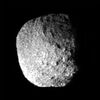Neptune has 13 known moons, which are named for minor water deities in Greek mythology. By far the largest of them is Triton, discovered by William Lassell on October 10, 1846, 17 days after the discovery of Neptune itself; over a century passed before the discovery of the second natural satellite, Nereid. Neptune's outermost moon Neso, which has an orbital period of about 26 Julian years, orbits further from its planet than any other moon in the Solar System.
Triton[]

Triton is the largest moon of Neptune. It was discovered on October 10, 1846 by William Lassell. It has an diameter of 2,707 km and a radius of 1,353 km, it orbits Neptune every 141 hours.
Laomedeia[]
Laomedeia is a prograde irregular satellite of Neptune. It was discovered by Matthew J. Holman on August 13, 2002. Its diameter is 42 km and its radius is 21 km.

Proteus[]

Proteus is the second largest moon of Neptune. It was discovered by the Voyager 2 spacecraft in June 16, 1989, It was named after Proteus, the self-changing sea god of greek mythology.